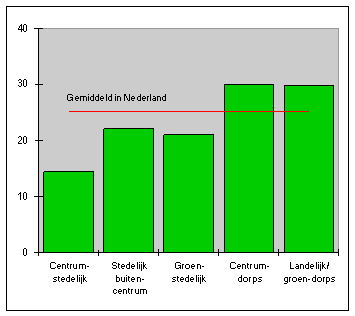Parents prefer rural environment

In the Netherlands families with under aged children relatively often live in areas with small towns and villages. They account for thirty per cent of the population in both village centres and in the countryside. There are fewer of these families in urban areas: only 14% of households in city centres consist of couples with children. The districts surrounding the city centres include slightly more families with children. Three in ten of these families are immigrants. They relatively often live in the flats in the outer districts of cities.
Living environment of parents with under aged children, 1999

Nuisance in residential environment
People who live in small towns and villages encounter fewer typically "city" problems than those living in more urban surroundings. Stench, dust, litter, noise, graffiti and vandalism, and nuisance caused by neighbours and traffic are more often encountered in strongly urbanised areas. For many parents traffic safety in their immediate surroundings is an area of concern. Only half of parents consider the roads where they live safe. Parents in urban areas in particular call the traffic situation dangerous.
At least three bedrooms
Most families with children, about 85%, live in a one-family dwelling with four or more rooms. Although on average the members of such households have 1.2 rooms at their disposal , one fifth of these families state that their house is too small. Among other household types, 14% think their house is too small. Nearly three-quarters of families with children own the house in which they live. For other household types, this share is 43%.
Wim Faessen
Source: CBS/VROM, Housing demand survey, 1999